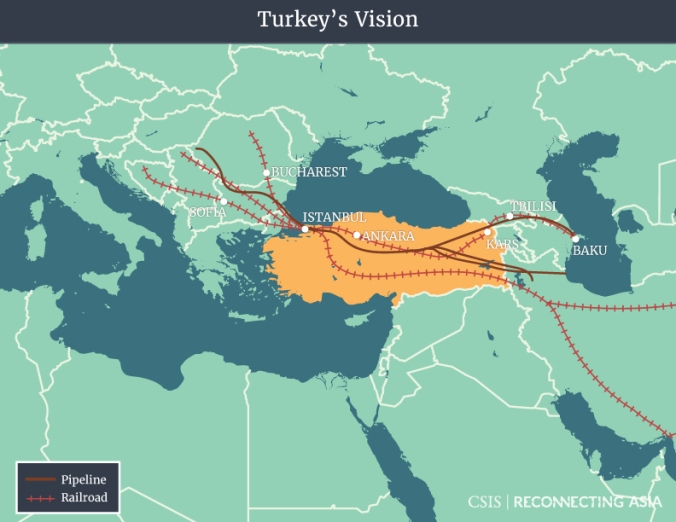Competing Visions
A geoeconomic contest is underway to shape Asia’s future. Regional powers are putting forward ambitious plans for building roads, railways, pipelines, and other hard infrastructure across the region. Drawing on official sources, CSIS experts developed the maps below to illustrate some of these competing visions. Each map captures, in broad strokes, the major infrastructure priorities of a leading actor. Collectively, these maps preview a competition as wide-ranging as the region itself. As this story unfolds, the collection below will be expanded and updated.
Announced in 2013, China’s “One Belt One Road” (OBOR) initiative drives across the Eurasian landmass in two grand sweeps: the ocean-based 21st Century Maritime Silk Road and the overland Silk Road Economic Belt. As Chinese President Xi Jinping’s signature foreign policy effort, OBOR is striking for its opacity as well as its ambition. On the surface, it imagines a future Eurasia where all routes lead to Beijing. As an open-ended framework, however, the initiative is less clear. It combines new and older projects, covers an uncertain geographic scope, and includes efforts to strengthen hard infrastructure, soft infrastructure, and even cultural ties.
India’s vision is primarily focused on increasing connectivity within its own borders. Looking outside its borders, India sees the South Asian Association for Regional Cooperation (SAARC) as largely paralyzed. Instead, the Modi government is focused on assembling smalls groups of its neighbors or « coalitions of the willing, » in support of its regional economic objectives. Other efforts reflect India’s geopolitical interests. By developing Chabahar Port in Iran, for example, India intends to bypass Pakistan and access overland routes to Europe and Central Asia. Looking even further, Prime Minister Narendra Modi’s “Act East” policy aims to strengthen links between India and ASEAN nations, giving India’s landlocked northeast region better access to its southern ports and establishing new land corridors connecting India to Thailandthrough Myanmar.

Prioritizing east-west connections, Japan’s vision stems from decades of investing in Southeast Asia, where existing infrastructure reflects the needs of Japanese supply chains, especially maintaining access to the sea. Japan is acting swiftly to defend this incumbent advantage, and has boosted funding to expand “high-quality and sustainable infrastructure” in the region through its Partnership for High Quality Infrastructure. Consistent with the Master Plan on ASEAN Connectivity, Japan is backing a number of new land and maritime corridors that would increase connectivity between the Bay of Bengal and the South China Sea. Japanese Prime Minister Shinzo Abe has also expanded Japan’s diplomatic footprint, becoming the first sitting Japanese leader to visit all five countries of Central Asia.
Russia’s vision combines soft and hard infrastructure. The Eurasian Economic Union (EAEU) is Russia’s primary vehicle for regional economic integration, and officials have suggested it could be linked with OBOR. Reinforcing its economic and diplomatic pivot to the east, Russia is tapping into the Chinese energy market with a series of proposed natural gas pipelines. To its south, Russia aims to increase connectivity with Azerbaijan, Iran, and India through the North-South Transport Corridor (NSTC). To its north, Russia is planning additional projects to advance its energy and defense interests as the Arctic becomes more accessible.

President Park Geun-hye’s Eurasian Initiative is expansive, incorporating railways from Seoul to the heart of Europe, shipping lanes through the Arctic, and enhanced fiber optic networks such as the Trans-Eurasia Information Network (TEIN) throughout Southeast Asia. Through increased diplomacy, South Korea is laying the groundwork for stronger relationships in the region and expanding its commercial relationship with Kazakhstan in particular. In light of current geopolitical obstacles, President Park’s initiative appears to contain both diplomatically ambitious and practical plans. Accounting for North Korea, this includes an imagined rail line through the demilitarized zone and an alternative undersea route for bypassing the North and connecting to Russia’s rail network.

Historically, Turkey has been a strategic land bridge connecting Asia and Europe while bypassing Russia. Today, Turkey is enhancing this position with major domestic, sub-regional and trans-national infrastructure projects such as the Baku-Tbilisi-Kars Railway. Turkey also plans to build thousands of kilometers of new roads and railways under the Vision 2023 initiative, which will mark a century since its independence. Collectively, these efforts would expand Turkey’s transportation networks and strengthen their connections with Asia and Europe.
Source: CSIS



A reblogué ceci sur Desseins Géopolitiques.
J’aimeJ’aime